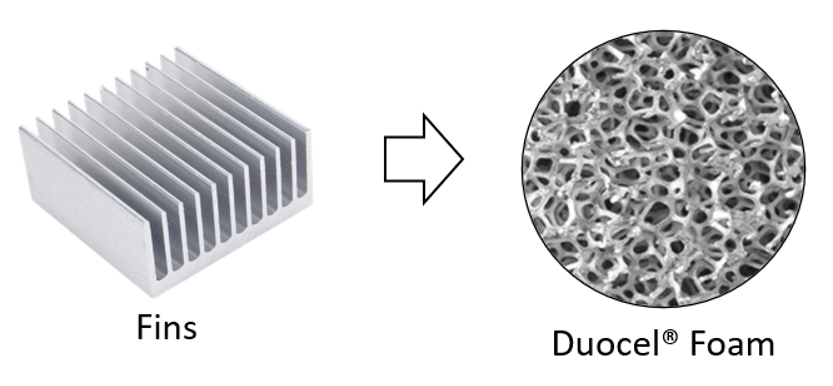What is a foam based heat exchanger?
A foam based heat exchanger is a compact and highly efficient technology that transfers heat between two or more fluids in order to control the thermal performance of critical components in a system. A common example of a typical heat exchanger is the radiator on a car, or the fan-cooled heat sink in a laptop. Foam based heat exchangers (typically aluminum or copper foams) operate on the same fundamentals as all heat exchangers, but with increased surface area and turbulent flow to maximize heat transfer, resulting in better performance in a smaller package. Metal foam can be applied to all types of heat exchangers as an alternative to traditional fins or microchannels. As new products and technologies push the limits of electronics, heat exchangers are required to remove more heat in smaller volumes. This positions Duocel® as a great design choice for high performance applications.

Why is Duocel® ideal for heat transfer applications?
Duocel® foam can elevate a heat exchanger design by utilizing the high surface area and high thermal conductivity of the foam structure to enhance the overall heat transfer of a system, all within a compact and lightweight form factor. Additionally, Duocel® has excellent manufacturability and shape package flexibility due to its high structural integrity, allowing for complex shapes and flow paths to be brazed or bonded into full assemblies.
The foam’s high surface area to volume ratio and ligament structure interrupts boundary layers, creating turbulent flow and enhanced mixing, resulting in higher heat transfer compared to conventional technologies. To optimize the Duocel® structure, ERG customizes the base material (primarily high conductivity metals like aluminum and copper), the pore size (smaller pores like a 40 PPI foam equates to higher surface area to volume ratio), and the ligament size (~8% relative density provides a good conduction path for the heat into the cooling fluid).
One additional factor to enhance heat transfer that is unique to Duocel® metal foam is the ability to compress the material by a factor of up to 6x. The solid ligament structure allows for ductile compression to increase surface area; most other metal foams have hollow ligaments, or have a buildup of layers that prevent ductile compression. Essentially all of the liquid single- and two-phase heat exchangers that ERG designs take advantage of compressed Duocel® foam in order to maximize performance in a small volume.
Duocel® foam cores can be machined and brazed into housings, creating an exceptional thermal interface and simplifying the overall system complexity which results in higher quality and more repeatable parts.
What types of heat exchangers benefit from using Duocel®?

Heat Sinks
Duocel® heat sinks are often thinner than standard fins, reducing the overall height by 66% of the heat exchanger.
Cold Plates
Duocel® coldplates can reduce the system complexity and conform to complex shapes better than traditional technologies. The structure’s enhanced mixing makes it a great choice for two-phase flow applications.
Phase Change Material (PCM) Heat Exchangers
PCM heat exchangers work exceptionally well for high heat flux, short duration events, as well as space-based cooling applications where air is not available to cool the system. The 3D structure of Duocel® foam acts as a matrix to enhance the conductivity of the PCM (typically a paraffin wax), resulting in a more complete transfer of heat into the PCM. As with other foam based designs, the ability to manufacture conformal PCM heat exchangers allows them to be used on components that traditionally have had to utilize sub-optimal cooling methods.
Why ERG?
ERG has designed, developed, and delivered over 1000+ liquid heat exchangers and high performance heat sinks for a wide range of industry applications. With precise adjustments of the Duocel® parameters, it is possible to meet the heat transfer, pressure drop and mechanical requirements for of a variety of designs. ERG has decades of experience, engineering expertise, and design data for everything necessary to model, prototype, and manufacture complete heat exchanger systems. With data-driven internal CFD models, the Duocel® structure can be customized to maximize performance in a given volume. ERG has a 50-year history of making quality Duocel® material, is certified to AS9100 Rev D, and is vertically integrated with a focus on customer service and turning ideas into production parts.

Advantages
- Compact, high performance designs
- Highly customizable for all modes of heat transfer
- Tunable for a wide range of heat fluxes
- Easy to manufacture into conformal shapes
- Can be brazed and bonded for excellent thermal interfaces
- Decades of design and testing data
Duocel®
- Maximize Surface Area to Volume Ratio with pore size and compression
- Meet mechanical requirements by tuning ligament cross section
- Solid ligaments allow brazing and bonding options for exceptional thermal interfaces
Types of Heat Exchangers
- Natural and Forced Convection heat sinks
- Liquid Coldplates
- Liquid to Air, Liquid to Liquid radiators
- Two-Phase coldplates
- Phase Change Heat Exchangers
Download More Information:
ERG has an in-house R&D lab for fundamental and prototype testing to ensure designs and models are validated prior to full scale production
